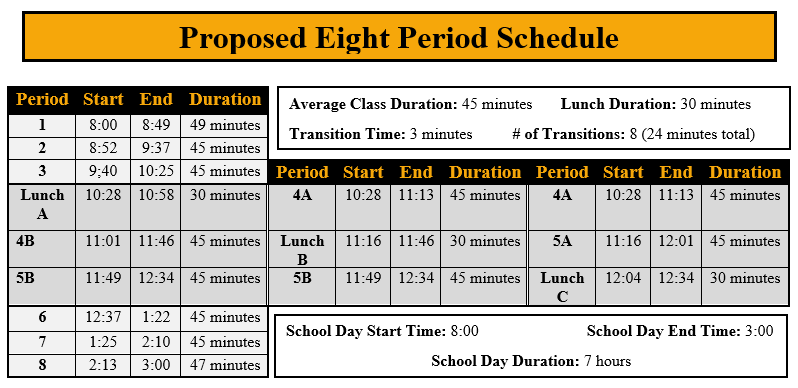After a decade with a four-block schedule, Milton Area High School will switch to an eight-period schedule next fall.
At a school board meeting on Feb. 13, Superintendent Dr. John Bickhart shared the leadership team’s goals for all Milton students, which included having “a solid, consistent schedule” for all of grades K-12. This plan includes a period schedule in the high school that does not rely on sharing teachers with the middle school, he added.
School board approval was not required to make the schedule change, according to Dr. Bickhart. “It is a district decision that I can make. … But [Feb. 13] is when I checked with the board to get their opinions,” he said. “Based on the K-12 vision, it’s time to move [the period schedule] forward.”
He added that when he became Milton’s superintendent, there was overwhelming agreement among the administrative team to consider a period schedule.
Dr. Bickhart said the team mostly discussed “what ifs” since the consideration process started last February. According to Dr. Bickhart, the administrative team considered options including keeping the block or creating a modified block schedule.
Last April, administration asked the opinion of teachers, students, parents, the school board and others who would be impacted by this decision, added Dr. Bickhart.
A majority of students who were surveyed supported blocks, said Dr. Bickhart, who added that he feels it is the schedule they were most familiar with. According to Dr. Bickhart, the teachers’ opinions were generally “50/50.”
“You’re trying to get buy-in and that’s always a roadblock. I want to communicate effectively and build as much support for a change,” said Dr. Bickhart. “However, I am also a realist.…You have to make a decision, but not everyone’s going to love that decision and that’s okay.”
Dr. Bickhart added that there is a “beauty” in aiming to get the support of all impacted. For example, he said the school board “challenged” the administrative team to look at a wider K-12 view. “You get people that ask questions…then you’re able to really work through the possible issues,” he added.
One concern the school board had was how CTE programs could meet their requirements and instructional hour commitments, said Co-Principal Mr. Andrew Rantz.
“Administration showed a sample schedule of how not only CTE programs would continue to meet all necessary requirements, they would have more consistent class meeting times throughout the year, and would actually increase their instructional hours by over 30 for the duration of the school year,” added Mr. Rantz.
On Feb. 16, principals from each of the district’s schools met with teachers to discuss the goals set for the district and the plans for the future of their school’s schedule, according to Dr. Bickhart. The next step at the high school is a curriculum review, he added.
In the upcoming months, teachers have time to adjust their curriculum to a 45-minute period for 180 days, compared to an 84-minute block for 90 days, said Dr. Bickhart. “The biggest adjustment for teachers is going to be that restructuring,” he added.
According to Mr. Rantz, there will still be a school wide Pride Time with the period schedule, but it will not be every day.
“At this time, there will not be any double blocks or 0.5 credit courses. However, we would definitely look at potentially adding those types of courses in the future based off how next year goes,” said Mr. Rantz.
According to Dr. Bickhart, a period schedule will come with several advantages that will increase opportunities for students. He said the administrative team’s goals are to reduce class sizes by providing more sections of already existing core classes, expand elective programs and offer more Advanced Placement (AP) courses. Mr. Rantz added these AP courses include AP Biology, AP Chemistry, AP Literature and AP Government.
“But as time goes on, we’re hopeful teachers see opportunities, and students talk to them so that new courses can be created,” said Dr. Bickhart.
Mr. Rantz added the only completely new course being offered next year is Introduction to Education, which is a part of the new Education CTE program.
Dr. Bickhart explained how a period schedule will get rid of the issue of teachers only having 90 days with students. With a period schedule, students have more teachers that they can go to all year long for support and guidance, according to Dr. Bickhart.
Dr. Bickhart said 84 minutes is “a long time to be in a class,” and a period schedule provides the opportunity to maximize both students’ and teachers’ time.
“This was never about which is better. It was about, at this time, what do we think philosophically is our best option? I am not convinced 84 minutes in four blocks is the best use of our time for kids,” said Dr. Bickhart.
He added the potential issue of someone taking a class first semester one year and not having that subject again until the second semester the following year will be eliminated with a period schedule.
According to Dr. Bickhart, many students expressed concern about more daily classes leading to more homework. He added that a period schedule should not mean more homework.
“The quantity of instruction time is equal to or greater in a period schedule, so we just need to maximize our minutes,” said Dr. Bickhart.
Dr. Bickhart said a potential drawback to transitioning to a period schedule is making sure students feel supported and not overwhelmed.
“It’s evident that change is difficult…People have to realize they’ve got to meet us halfway and be ready to embrace the change a little bit. Then it’s our job to make as much layers of support as we can for them,” added Dr. Bickhart.




